

Cleaning out the e-mail, Part 1
We're all back in our places with bright shiny faces as we kick off the new year here at NHRA. Some staff members are still unpacking and setting up their work areas after last month's move, and we spent yesterday afternoon in a planning meeting for National DRAGSTER, critiquing our efforts in 2010, brainstorming about 2011, and getting a head start on some of the year's early issues. The first issue of ND for this year does not print for another two weeks, but there's still plenty to do.
Before we launch into Insider v2011, I thought I'd take this opportunity to clear the deck of all old business. I get a ton of e-mail from the rabidly tuned-in audience here and can't publish all of it, but I do read every piece (and respond as possible) and keep much of it for possible future use, so I'm going to go through my many Insider e-mail folders and make sure I catch anything I might have overlooked -- not only last year but beyond -- before diving headfirst into a new season here. This is the first of two parts.
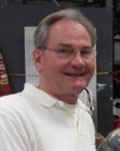 |
I got to meet Tom Jobe – one third of the famous Jobe-Skinner-Sorokin Surfers Top Fuel team of the 1960s -- last year at the get-together at Don Prudhomme's shop, but we had been exchanging e-mail for a long time before that. I came across this message, from 2008, that I had been holding on to for some reason. We had been talking about the Surfers car, and I had mentioned to him that many old fans said that they could identify the car by its engine sound alone, so I asked him about it. I don’t think I ever published his comments; if I did, I apologize and still think it's worthy of telling the story of one of the popular teams of that era.
"At Pomona in the 1960s, you push-started along the back property line and made a sharp left turn out onto the dragstrip. The spectators could hear the cars running before they would see the cars turn onto the dragstrip, and when we would push down and make the turn onto the dragstrip, the people in the stands would already be up on their feet chanting 'Surf's up.' The sound of our car was distinctive enough that everyone knew it was the Surfers before they ever saw the cars. It was quite a sight because no matter who we were racing, the crowd was always cheering for us, anywhere we raced.
"As for the sound, it is a long story, but when we were first scheming on how we could possibly run a Top Fuel dragster, we figured out that no one really understood nitromethane and how to use it properly, so I set about studying nitromethane in the early 1960s. During the time we were building and running our dragster, I was going to college full time taking mechanical engineering. I worked hard on learning about everything we needed to know more about, including nitromethane, and I got the professors at school involved in my problems to help keep me straight on the theory as we went. A study of the energy available from nitromethane (combined with a fixed amount of air) showed us that it was absolutely foolish to run anything less than 100 percent nitro unless practical issues required using less. It also revealed that we needed to burn the nitromethane and not detonate it if we were ever going to be successful at drag racing.
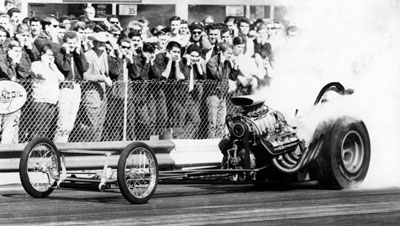 |
"As we worked on our combination at the drags, it turned out that it was just too hard to get the car started reliably with 100 percent on cold Saturday nights, so we eventually settled on 97 percent nitro and 3 percent toluene (with some blue food dye, just to mess with people's minds). This mixture was arrived at by studying everything I could get my hands on about nitromethane, including the research done on some huge unexplained explosions of nitromethane in the late 1950s. One of these explosions was a pair of rail tank cars out in rural Illinois. The government and the makers of nitromethane (Commercial Solvents Corp.) published a lot of good information on their tests to see what detonated the two rail cars. They looked into the effects of every possible thing that could have been in the tank cars to contaminate the nitro to see how these contaminants could have sensitized (or desensitized) the nitro. They devised a very scientific method to test the effects of every possible contaminant at 5 percent by volume, which gave us a good way to evaluate what we should be putting in our fuel to make the starting reliable at night and help suppress the detonation which would kill our nice junkyard 392 Chryslers. Another thing that came out of this nitromethane study was the critical need to atomize the fuel better in order to burn it (rather than detonate it), so we ended up running lots of tiny homemade nozzles with at least three times the fuel pressure anyone else had. These were some of the advantages we had that no one could see or figure out, which might help explain why no one else had the 'Surfers sound' (or the reliability that went with it)."
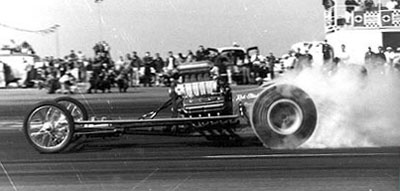 |
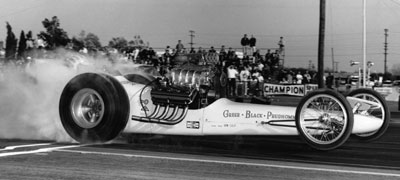 |
Our Favorite Race Car Ever voting in the summer of 2008 naturally included the vaunted and nearly unbeatable Greer-Black-Prudhomme Top Fueler of the early 1960s. I'm not sure that a lot of even the hard-core fans know that the car was not originally driven by Prudhomme nor even owned by Tommy Greer before "the Snake" found his fangs in the car. Stephen Justice, a veritable encyclopedia of early 1960s drag racing, had dropped me a line then (again, I don’t think I ever published this factoid, but if I did, it still bears sharing) to tell me of the car's lineage. "Kent Fuller originally built the car in 1961, and it was campaigned in Northern California as the Cash Auto Parts Special and was driven by Archie Liederbrand. Later, the car was repossessed by Lou Senter (from the guy who owned Cash Auto) and raced as the Ansen Automotive Special. Rod Stuckey drove it for Senter, including at the 1962 March Meet (pictured, top). After Prudhomme won Bakersfield in 1962, Senter purchased the Prudhomme-Zeuschel-Fuller car and sold the '61 Fuller car to Greer. Greer had Fuller update the car and Keith Black build an engine. Prudhomme drove for Senter some but was replaced with Tommy Dyer. Greer needed a driver, and although Stuckey was considered, Prudhomme ended up getting the ride. The revamped Greer-Black-Prudhomme fueler debuted at Pomona on June 17, 1962, and promptly won Top Eliminator over 'Lefty' Mudersbach the first time out with a time of 8.73, 177.51."
 |
Speaking of Prudhomme, here's another shot I received during the voting but never published. Jeff Thomas (aka JW Last, founder of the great 70sFunnyCars.com site) sent this great pic of "the Snake's" Hot Wheels wedge during qualifying at the 1971 Summernationals. He wrote, "Love this shot because it shows the changing of the guard from old front-motor technology (complete with short wheelbase) to back-motor technology ... albeit with aerodynamics which were later abandoned. The front-motor car is the Roy Mattox car, which I believe took runner-up at the event while 'Snake's' wedge failed to make the show (if I remember correctly, which all these years later, I might not)." That is indeed the Mattox car in the far lane, driven by Jim Hornsberger, who famously beat Don Garlits early in eliminations but could not contest the final against Arnie Behling in Bruce Dodd's Spirit rear-engine car after suffering heat prostration while working on his wounded mill between rounds. Prudhomme did, however, qualify for the event, running a 6.70, 223.88 for the No. 5 spot (behind Herm Petersen, Behling, Garlits, and Tom McEwen), but invalidated a better-yet first-round 6.68 with a red-light to unheralded Dick McFarland and his new back-motor machine.
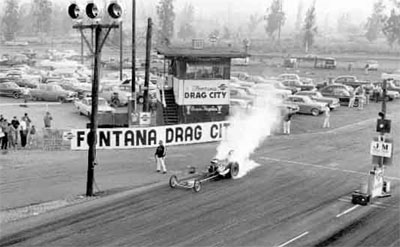 |
Reader William Morrel asked me way back in September 2009 if I had any shots of the old Fontana racetrack here in Southern California. "I grew up in Fontana in the '60s and visited the Fontana dragstrip on Foothill Boulevard many, many times. Many fantastic night races were held there in 'The Day:' 'Big John'; the Surfers; Greer, Black & Prudhomme; Weekly, Rivero, Fox, and Holding; 'Dandy Dick' Landy, and the list goes on. I believe 200 mph had not been broken yet, but on many occasions, 198 was often achieved there. As a young boy, I lay in bed and could hear the Top Fuelers from -- and I am guessing -- 5 miles due south of the strip where I lived. When I could attend a race, the old wooden grandstands, with the round iron guardrails, were packed to full, and the smoke, the smell, the floating rubber filled the air, and IT WAS PERFECT. Perhaps you might have some photos from back in 'The Day' at Drag City." At the time I didn't, but now I do. Enjoy, William.
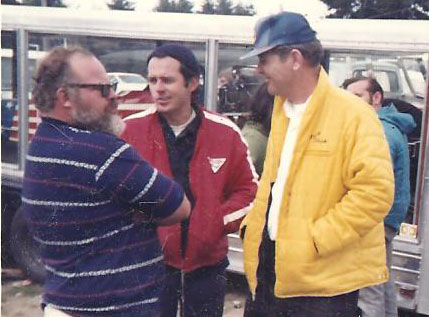 |
 |
As part of NHRA's 60th anniversary salute, I was asked to compile a list of memorable moments from the past six decades, from which the final top 60 were selected (and will be revealed soon). I don't think it's any kind of giveaway to say that the first five-second Top Fuel pass – by Mike Snively in Jim Annin's Top Fueler at the 1972 Supernationals at Ontario Motor Speedway – is definitely on that list. Reader Ray Romero of Spokane, Wash., sent this pic in late 2009 that I really like, showing, from left, Annin, Snively, and engine great Keith Black in the pits at Seattle Int'l Raceway earlier that year. Sadly, all three are no longer with us.
The fine folks at Auto Imagery, who have been around to see much of that history made, provide the images for our popular Photo of the Week section and have a wide variety of stuff beyond just the gorgeous photos of vintage cars that typically run there. Auto Imagery boss Rick Shute sent me this great photo last year, which didn't make it to the POW section but is certainly worth sharing as it's pretty rare. You always hear John Force lauding "Uncle Beavs," Gene Beaver, for guiding him on his Funny Car path, and here are the two of them bookending this pic, which was shot in Gainesville in 1982. The two guys in the center are also noteworthy: Billy McCahill and Force's brother, Louie. Beaver, of course, was part of many Funny Car efforts – most notably with the Condit Bros. – and McCahill had a short-lived but splashy career as the driver of the HB Gold Citation in the early 1980s. I can't recall the details, but I believe that he's related to either Force or Beaver somehow. "Diesel Louie" followed brother John to the racetrack but as an exhibition driver wheeling a series of wheelstanders. Great family photo.
My "sister from another mother," Dawn Mazi-Hovsepian, sent me a link to the video above, which is posted on her YouTube page. It showcases her family's popular supercharged BB/A Opel GT running at the 1984 Springnationals in Columbus. The car, of course, means the world to me because I got to drive it later that summer for a two-part story that ran in National DRAGSTER (and is reprinted on Dawn's site: Part 1, Part 2). Although the car was replaced a year later with a newer, tricker, and quicker Trans Am, I still love to watch and hear this car run. Just looking at its attitude as it sits on the track makes me wonder why I ever thought I could drive it. There's barely room for a human being to fit in the car, and the driver sits in a semi reclined position with the throttle pedal up high on the transmission tunnel. It truly was one of the most amazing experiences of my life, and seeing the car run again gave me chills.
More great stuff from the folders Friday!



















































